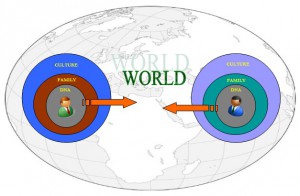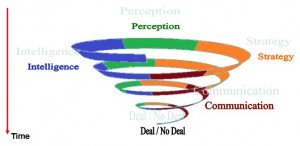Traditionally, negotiation processes are considered as a blend of various disciplines ranging from game theory, psychology, political science, communications, law and sociology to anthropology. E-negotiations can be seen as the subset of negotiations that relies exclusively on technology. Their major advantage is their ability to record every detail of the communication process including intentions, outcomes and information exchanged. This can provide a better understanding of the negotiation process and behavior and allow analysis and evaluation of strategies that would be impossible in face-to-face negotiation. Additionally, the resulting time lag from the asynchronous communication exchange has been shown to make negotiators pay more attention to the substantive content of messages, lessened the emotional stress brought about by conflicting positions and made it easier to overcome socioeconomic differences.
The challenges that someone is faced when negotiating online can many times outweigh its benefits. The lack of face and body queues are very difficult for many to overcome and make sense of the cold and biased towards English text messages. The fact that you might be typing from left to right while someone else reads from right to left or top to bottom might seem trivial but it can have profound differences on how things are expressed and interpreted. Perceptions of time are another cause of misinterpretations and misunderstanding. Imagine you speak a language were there is no future tense or the verb “to be” does not exist. These are realities that exist between languages and even between variations of the same language like English.
As Figure 1 shows messages we send and receive go through layers of influence that can be affected by our heritage whether genetic, social or cultural and the environment in which we operate. If that isn’t enough it gets worse when we consider the same for the person we are negotiating. It’s a kind of filtering that any negotiator needs to be aware off if they are to code their message to clearly reach another party. Decoding the messages on the receiver side is also vital unless the other party is aware and trained enough to code their message so it doesn’t get polluted by the different influence layers.
One way that we can help someone is by providing a framework that will ensure all the parameters of a negotiation issue and the positions of the interested parties are understood and projected clearly. This is nothing more than a model of a process and in our case the steps that we consciously or unconsciously make to reach our goal. Making it visible is meant to help in making us aware of what is going on and how we can make the most of it. As figure 2 outlines, e-negotiations like most negotiations is about looking for the characteristics of a situation, making sense of it, planning an action and executing it. We start with the intelligence phase where we try to find as much information as possible about the issue at hand and the parties involved. We then try to make sense of what we found and based on that we build our negotiations strategy. Finally we execute the strategy by communicating our intentions and our proposals.
It is expected that while initially more time will be spent in intelligence and perception and less in strategy and communication, this will reverse the closer you get to the final outcome. In the beginning, you need to spend more time learning about the issues at hand and understanding our opponent, while as the process matures and we get more feedback, our understanding grows and the opponent’s positions and needs become more obvious. The opposite is true for the strategy and communication phases since the need to move from exploratory positions and offers to a more precise and detailed final position grows in time. At later stages, communication becomes more intense. So while the cycle remains more or less the same in terms of sequence of its phases, the time spent in each phase changes drastically and is directly influenced by the personality, state of mind, and experience of each negotiator.
Negotiation strategies have been identified in the literature ranging from distributing, avoiding, accommodating, integrating, compromising, collaborating, and exploiting, to competing, among others. Naturally, negotiators don’t necessarily belong in exact stereotypes, but the general rule is that if the spiral doesn’t progress in the intended fashion then there is something seriously wrong in the negotiation. Competitive negotiators tend to spend more time in the last phases of positioning and communication while cooperative ones spend more time in understanding the opponent and position accordingly.
If we could put everything into a one rule (the root of all rules) I would say that all can be compressed in one world ‘empathy’; our ability to understand the feelings and needs of another or in simple terms to be in their shoes whether it is our partner, our customer, our sponsor or even our own self. This of course doesn’t necessarily mean being nice to someone. It simply means you can feel what makes them happy, what they fear, what they respect and even what they will follow.
It should be taken as a certainty for the future ahead of us that e-negotiations and the technology supporting them will create new and unique advantages and disadvantages. The absence of traditional social cues and their substitution with new forms could lead to more objective evaluations, while also diffusing identity perceptions and lessening self-awareness. The situation will be worse in cross-cultural communication due to lack of non-verbal signs and the necessary building up of trust. On the other hand, communicating through the Internet defies logistic boundaries of time, place and hierarchy, and allows focused considerations of task content and performance.
Nicholas Harkiolakis has taught international marketing and cross-cultural negotiations at theNormandy Business School in France and he is currently Visiting Fellow and the BrunelBusiness School in UK. He recently published “E-Negotiations: Networking and Cross-Cultural Business Transactions” (www.e-negotiations.org).


